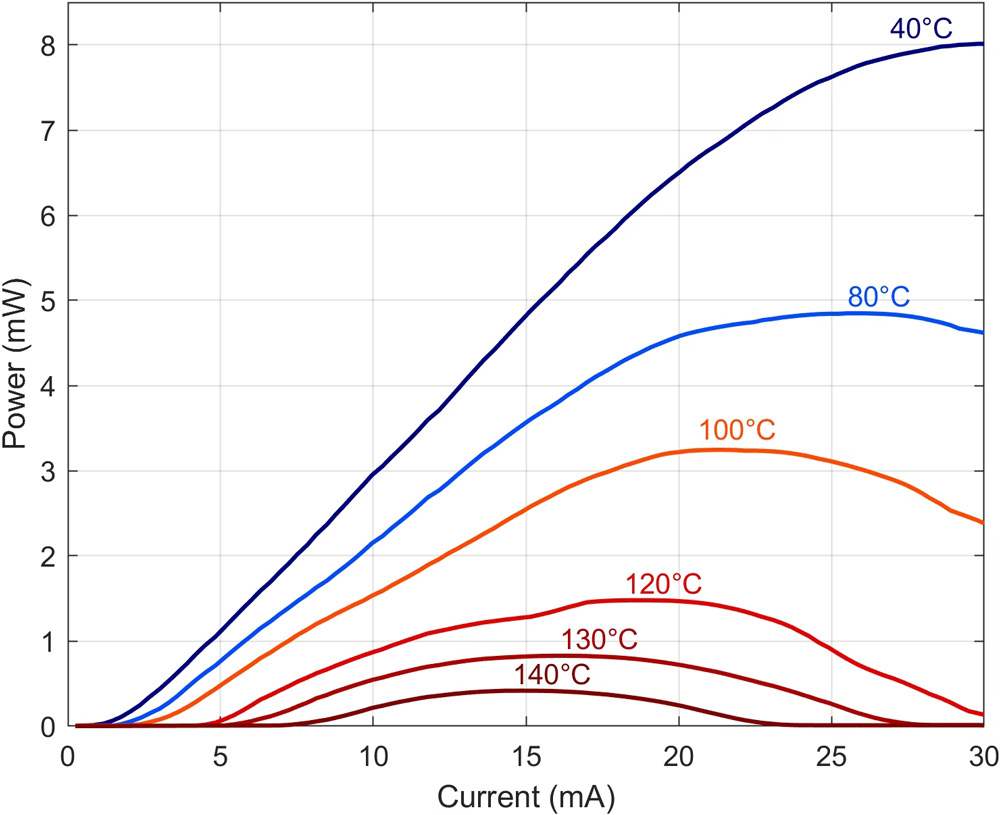News: Optoelectronics
1 February 2023
TRUMPF Photonic Components GmbH of Ulm, Germany (part of the TRUMPF Group) – which makes vertical-cavity surface-emitting lasers (VCSELs) and photodiodes for the consumer electronics, datacoms, industrial sensing, heating and automotive markets – is industrializing the production of short-wave infrared (SWIR) VCSELs above 1300nm to support high-volume applications such as in smartphones in under-OLED applications.
The firm says that it has demonstrated outstanding results regarding the efficiency of infrared laser components with long wavelengths beyond 1300nm on an industrial-grade manufacturing level, representing a step further towards mass production of indium phosphide-based (InP) VCSELs in the 1300–2000nm range.
“We are working hard to mature this revolutionary production process and to implement standardization, which would further develop this outstanding technology into a cost-attractive solution. We aim to bring the first products to the high-volume market in 2025,” says CEO Berthold Schmidt.
By developing the new industrial production platform, TRUMPF is expanding its current portfolio of gallium arsenide (GaAs)-based VCSELs in the 760–1300nm range for NIR [near-infrared] applications. The new platform is more flexible in the longer-wavelength spectrum than are GaAs, but it still provides the same benefits as compact, robust and economical light sources.
“The groundwork for the successful implementation of long-wavelength VCSELs in high volumes has been laid. But we also know that it is still a way to go, and major production equipment investments have to be made before ramping up mass production,” says Schmidt.
VCSELs to address new applications
TRUMPF reckons that a broad application field can be revolutionized by the industrialization of long-wavelength VCSELs, as the SWIR VCSELs can be used in applications with higher output power while remaining eye-safe compared with shorter-wavelength VCSELs. The long-wavelength solution is not susceptible to disturbing light such as sunlight in a broader wavelength regime.
One popular example from the mass markets of smartphone and consumer electronics devices is under-OLED applications. The InP-based VCSELs can easily be put below these OLED displays, without disturbing other functionalities and with the benefit of higher eye-safety standards. OLED displays are a huge application field for long-wavelength sensor solutions.
“In future we expect high-volume projects not only in the fields of consumer sensing, but automotive LiDAR, data communication applications for longer reach, medical applications such as spectroscopy applications, as well as photonic integrated circuits (PICs), and quantum photonic integrated circuits (QPICs),” says Schmidt. “The related demands enable the SWIR VCSEL technology to make a breakthrough in mass production.”
Test results up to 140°C at ~1390nm wavelength
TRUMPF is presenting results showing VCSEL laser performance up to 140°C at ~1390nm wavelength. The technology used for fabrication is scalable for mass production and the emission wavelength can be tuned between 1300nm to 2000nm, resulting in a wide range of applications. Recent results show good reproducible behavior and excellent temperature performance. “We are confident that the highly efficient, long-wavelength VCSELs can be produced at high yield to support cost-effective solutions,” Schmidt says.

Picture: Temperature performance of the light-current measurement of multimode VCSEL at up to 140°C with 1390nm.
TRUMPF Photonic Components is exhibiting in booth 539 at SPIE Photonics West 2023 in San Francisco, CA, USA (28 January to 2 February).
www.spie.org/conferences-and-exhibitions/photonics-west
www.trumpf.com/s/VCSEL-solutions
- SEO Powered Content & PR Distribution. Get Amplified Today.
- Platoblockchain. Web3 Metaverse Intelligence. Knowledge Amplified. Access Here.
- Source: https://www.semiconductor-today.com/news_items/2023/feb/trumpf-010223.shtml



